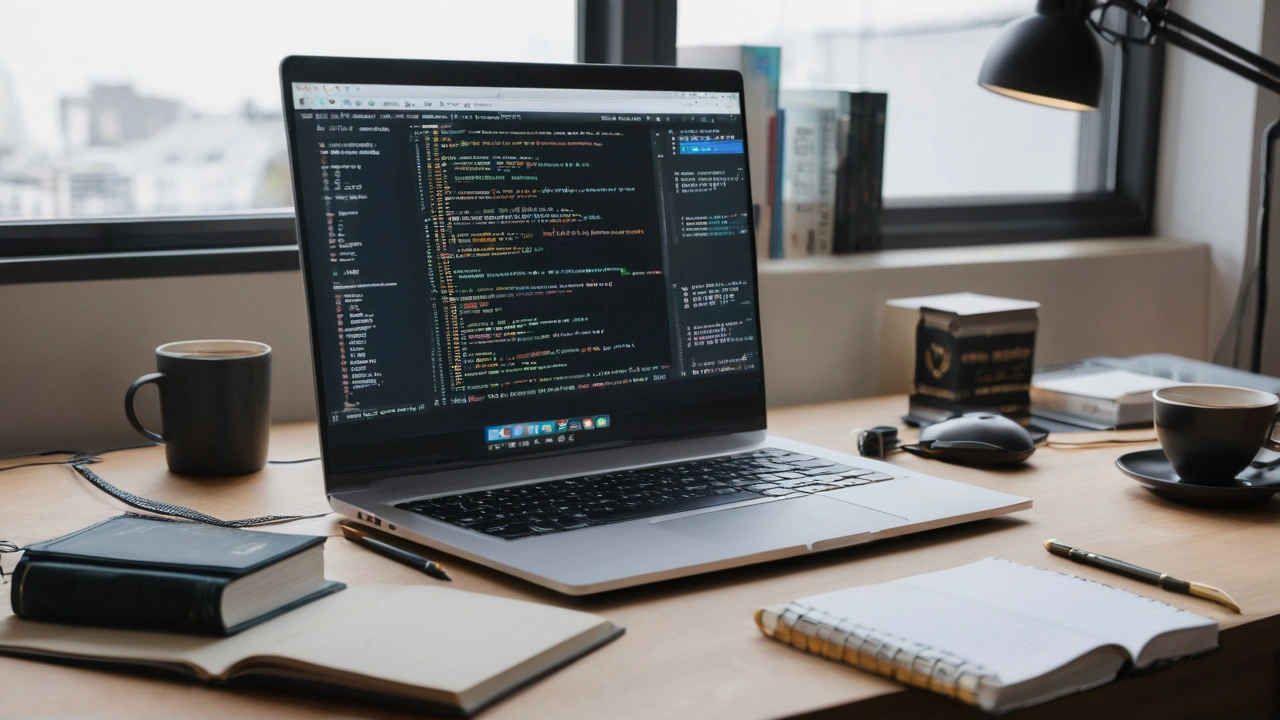Diving into Python programming can feel like exploring a vast, uncharted ocean. Whether you're just starting out or looking to polish your skills, having a few key tricks up your sleeve can make a world of difference. Python is known for its simplicity and readability, but there's always room to learn something new and exciting.
In this guide, we will break down some of the most useful Python tricks that can elevate your coding game. From neat shortcuts to advanced techniques, these tips will help you write cleaner, more efficient code. Whether you aim to streamline your development process or avoid common pitfalls, this guide has got you covered.
- Introduction to Python
- Essential Tips and Shortcuts
- Advanced Techniques
- Common Pitfalls to Avoid
- Resources and Further Learning
Introduction to Python
Python has emerged as one of the most popular programming languages in recent years, known for its simplicity and versatility. Created by Guido van Rossum and first released in 1991, it was designed to emphasize code readability and easy syntax. This makes Python an excellent choice for both beginners and experienced developers.
The language is named after Monty Python, a beloved British comedy group, not the snake. Python’s ecosystem is rich with libraries and frameworks, which contribute to its wide-ranging applications, from web development and automation to data analysis and artificial intelligence.
One of the core reasons for Python's rise to fame is its simplicity. The language uses indentation to define code blocks, reducing the need for verbose syntax found in other programming languages. This not only helps keep your code clean but also makes it easier to debug and maintain.
Python's elegant syntax allows developers to express concepts with less code. For instance, tasks that may take dozens of lines of code in other languages can often be done in just a few lines in Python. This reduction in boilerplate code enhances productivity and allows for rapid development cycles.
A study by Stack Overflow in 2023 revealed that Python continues to be the fastest-growing major programming language, driven by its use in emerging fields like data science. Tech giants like Google, Facebook, and Instagram are known to use Python for various aspects of their operations. This widespread adoption is a testament to its robustness and reliability.
According to Guido van Rossum, “Python is an experiment in how much freedom programmers need. Too much freedom and nobody can read another's code; too little and expressiveness is endangered.”
Python's community is another vital aspect of its success. An active and helpful community can be a significant resource, whether you are struggling with a piece of code or looking for best practices. Websites like Stack Overflow, GitHub, and Reddit have dedicated spaces where Python enthusiasts share tips, answer questions, and offer support.
Ultimately, Python's versatility allows it to be used in numerous domains. Here are some areas where Python shines:
- Web Development: Frameworks like Django and Flask help build robust web applications efficiently.
- Data Science: Libraries like Pandas, NumPy, and SciPy are staples in data analysis and manipulation.
- Machine Learning: TensorFlow and scikit-learn are popular for building and deploying machine learning models.
- Automation: Tools like Selenium and Scrapy are used for web scraping and automation tasks.
If you're new to Python, you're stepping into a world of endless opportunities. It's a language that grows with you, helping you tackle increasingly complex problems as you advance. Embrace the journey, and you'll find that Python is not just a language but a gateway to endless creativity and innovation.
Essential Tips and Shortcuts
As any seasoned Python developer will tell you, mastering a few essential tips and shortcuts can significantly boost your productivity and make your code more efficient. Let's dive into some practical insights that might just change the way you code.
First and foremost, get comfortable with using Python's built-in functions. These are a treasure trove of pre-written code that can save you a lot of time and effort. For example, functions like len() for measuring the length of lists or strings, or type() to check the type of a given variable, can significantly streamline your coding process.
Another invaluable tip is to leverage list comprehensions for creating new lists by applying an expression to each element in an existing list. It's not just concise but also readable. Compare these two approaches: using a for loop to populate a list versus a single line of list comprehension. You'll find the latter to be much more elegant and expressive.
Indentation is the heart and soul of Python. It’s crucial to keep your code consistently indented to maintain readability and avoid syntax errors. A common mistake is mixing tabs and spaces, which can lead to errors that are hard to debug. Stick to using spaces and configure your code editor to automatically convert tabs to spaces.
Using virtual environments is another best practice that separates dependencies for different projects. This ensures that the libraries and packages used in one project do not interfere with those in another. The venv module in the Python standard library is a handy tool to quickly create and manage isolated environments.
Writing readable, well-documented code is also essential. Use meaningful variable names and include comments to explain complex parts of your code. Follow the PEP 8 style guide for Python code to keep your code clean and consistent. Think of your future self or colleagues who might work on the code after you.
Exception handling is a critical aspect of Python programming. Use try-except blocks to handle exceptions gracefully, ensuring your program can handle unexpected situations without crashing. Remember to be specific in catching exceptions; catching all exceptions with a bare except: clause can hide bugs and make debugging difficult.
Albert Einstein once said, "Everything should be made as simple as possible, but not simpler." This rings true in Python development, where simplicity and clarity are paramount.
Lastly, learning about Python's global and nonlocal keywords can be very useful. These keywords allow you to modify variables outside of your immediate local scope, providing more control over variable values in nested functions and larger scripts.
These tips and shortcuts are fundamental, but don’t stop here. Python is a vast language with continuous updates and a vibrant community. Staying curious and engaging with other developers will always elevate your skills.

Advanced Techniques
As you become more comfortable with Python's basics and intermediate concepts, it's time to delve into some advanced techniques that can make your programs more efficient and powerful. One such technique is using list comprehensions, a concise way to create lists. Instead of writing multiple lines of code, you can achieve the same functionality in just one line. This not only saves time but also makes your code more readable.
List comprehensions aren't limited to simple operations. They can include conditions, making it possible to filter elements while creating a list. For example:
numbers = [1, 2, 3, 4, 5, 6]
even_numbers = [num for num in numbers if num % 2 == 0]
print(even_numbers)This will output [2, 4, 6], demonstrating how concise and powerful list comprehensions can be. Another advanced technique involves using generators. Generators allow you to iterate over data without loading the entire dataset into memory, which can significantly reduce memory usage. This is especially useful when working with large files or data streams.
You can create a generator using a function with the yield keyword:
def generate_numbers():
for i in range(10):
yield iThis function will return a generator that produces numbers from 0 to 9. You can then iterate over this generator just like a list, but with the advantage of on-demand computation.
Python expert Raymond Hettinger said, "Generators are like stream processing on steroids."
Moving on to another powerful feature: decorators. Decorators provide a way to modify or enhance functions and methods dynamically. They are often used for logging, access control, and memoization. Here's an example of a simple decorator that logs the execution time of a function:
import time
def timer(func):
def wrapper(*args, **kwargs):
start_time = time.time()
result = func(*args, **kwargs)
end_time = time.time()
print(f"{func.__name__} executed in {end_time - start_time} seconds")
return result
return wrapperBy applying this decorator to any function, you can automatically measure and print its execution time. This can be a valuable tool for performance optimization.
Lastly, let's talk about context managers, which help manage resources like files or network connections efficiently. You might be familiar with using with open('file.txt', 'r') as f to handle file operations. This ensures that the file is properly closed, even if an error occurs. To create your own context manager, you can use the contextlib module:
from contextlib import contextmanager
@contextmanager
def managed_resource(name):
print(f"Opening resource: {name}")
yield
print(f"Closing resource: {name}")Using this custom context manager:
with managed_resource('my_resource'):
print('Using resource')You will see:
Opening resource: my_resource
Using resource
Closing resource: my_resourceEach advanced technique covered here enhances your coding toolkit, making your Python development more efficient and robust. Remember, the key to mastering these techniques is consistent practice and application in real-world projects.
Common Pitfalls to Avoid
Even the most seasoned Python developers can trip over some common pitfalls. Knowing about these before you start coding will save you a lot of time and frustration. Let's delve into a few mistakes that often catch developers off guard.
One of the main pitfalls is improper use of indentation. Python relies heavily on indentation to structure code, and a single misplaced space or tab can cause your code to break. Always ensure that your code blocks are consistently indented. Mixed spaces and tabs can be particularly troublesome, so it's best to choose one and stick with it. Using a code editor that highlights indentation issues can be very helpful.
Another frequent mistake is mismanaging mutable default arguments in functions. Setting a mutable data type like a list or dictionary as a default argument can lead to unexpected behavior. This happens because the default argument is only evaluated once when the function is defined, not each time the function is called. To avoid this, set the default argument to `None`, and inside the function, check if the parameter is `None` and then set it to an empty list or dictionary.
Unit testing is another area where developers often falter. Skipping tests or writing ineffective tests can lead to bugs going unnoticed until much later in the development process. Dedicated unit tests ensure that your code works as expected under various conditions, significantly reducing the chance of bugs. Utilize frameworks like `unittest` or `pytest` to make this process easier and more efficient.
Handling exceptions improperly is another common issue. While it's tempting to use a broad `except` statement to catch any kind of error, it can make debugging much harder. Instead, catch specific exceptions that you anticipate, and use meaningful error messages to understand what went wrong. This practice not only makes your code more robust but also significantly eases the debugging process.
Developers often overlook the importance of proper documentation. Clear and concise comments, docstrings, and README files contribute to better code readability and maintenance. They are crucial when you're working in a team or returning to your own code after some time. Good documentation can also assist other developers in understanding and contributing to your codebase.
Memory management can be tricky in Python, especially with large data sets. Failing to release memory properly can lead to leaks, slowing down your program over time. Utilize built-in tools like `gc` for garbage collection and try to work with generators when handling large datasets to manage memory more efficiently.
“Errors should never pass silently. Unless explicitly silenced.” — The Zen of Python by Tim Peters
Another common pitfall is not optimizing loops. Nested loops, in particular, can dramatically affect performance. Always look for opportunities to simplify loops and use list comprehensions where possible. These can make your code not only faster but also more readable.
Lastly, ignoring community best practices and updates can be a significant stumbling block. Python is an evolving language, and new updates and community guidelines are released regularly. Staying up-to-date with these can help you avoid deprecated practices and take advantage of new, more efficient ways to write code.

Resources and Further Learning
Once you've got a grip on the basics and some advanced Python tricks, the best way to keep improving is through consistent learning and practice. The Python community is incredibly vibrant and supportive, offering a multitude of resources that can help you deepen your understanding and stay updated with the latest trends.
One of the most valuable places to start is the official Python documentation. It's thorough, well-structured, and constantly updated. You can find detailed explanations for Python's built-in functions, libraries, and modules, which can help you tackle almost any problem you encounter. For those who prefer a more hands-on approach, interactive platforms like Codecademy and Coursera offer excellent courses that range from beginner levels to more advanced topics.
Books are another invaluable resource. Titles like 'Python Crash Course' by Eric Matthes and 'Automate the Boring Stuff with Python' by Al Sweigart are frequently recommended. They provide practical examples and projects that can build your confidence and skills incrementally. These books are particularly useful because they present real-world problems and solutions, making the learning process more relatable and engaging.
“Any fool can write code that a computer can understand. Good programmers write code that humans can understand.” — Martin Fowler
Do not underestimate the power of communities and forums. Sites like Stack Overflow and Reddit’s Learn Python subreddit offer platforms where you can ask questions, share insights, and learn from the experiences of others. Whether you're stuck on a specific problem or curious about best practices, these communities can be a treasure trove of advice and solutions.
Free Software and Tools
There are also various free or open-source tools that you can utilize to enhance your Python programming skills. Integrated Development Environments (IDEs) like PyCharm and Visual Studio Code offer features such as code autocompletion, debugging, and version control integrations. These features can significantly improve your programming efficiency. Online platforms like GitHub not only allow you to store and share your projects but also to explore countless other projects, giving you an endless supply of inspiration and learning opportunities.
To keep your skills sharp, consider participating in coding challenges and competitions. Websites like HackerRank and Codewars offer coding exercises that can help you think creatively and solve complex problems. These challenges can be an entertaining way to practice and improve your coding prowess.
Podcasts and YouTube channels are another great way to learn on the go. Shows like 'Talk Python To Me' and YouTube channels like 'Sentdex' provide insights on current trends, interview experts, and offer tutorials on specific topics. This can be a convenient way to integrate learning into your daily routine.

